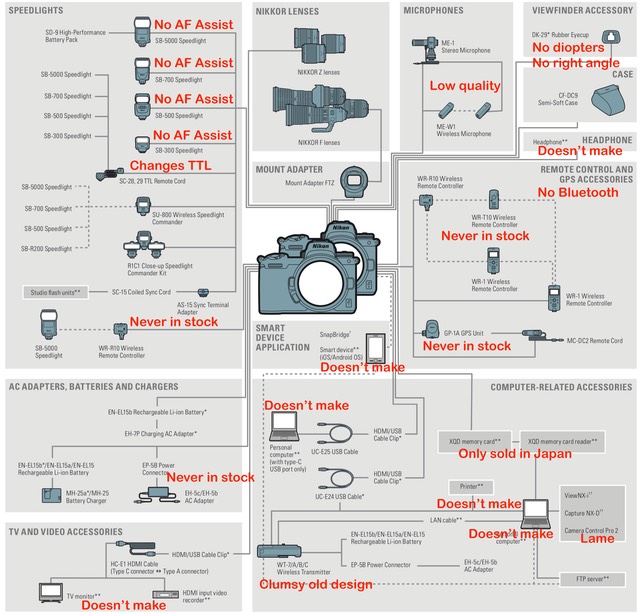The Japanese camera makers all pretty much refer to mirrorless cameras as "compact systems cameras." So here's a question: what do they think the "system" is?
It's clear that everyone understands that a system has bodies and lenses. After all, these are "interchangeable lens cameras" (ILC as CIPA refers to it). But is that it? Bodies and lenses are the whole system?
I'm going to pick on Nikon today because I know their "system" so well now that I count Nikon product model numbers to go to sleep. But what I'm about to write pretty much applies in similar ways to all the so-called compact systems cameras from every manufacturer.
Let's start with flash. Nikon punted. Heck, they even removed features.
Grips? Nikon punted. Sorry, cameras aren't used vertically any more.
Remotes? Nikon dithers and fails to stock what they do make.
Bellows? Nope, macro lenses are all you need.
Arca plates? Nikon doesn't realize that every serious shooter is using them.
Power? Missing AC accessories, missing powered-from-USB cameras.
Software? Rebranding Silkypix is not the same as creating useful software.
Workflow? See software, but also note that camera makers basically throw up their hands once you've actually pressed the shutter release. What happens after that if they support something, like SnapBridge, has marginal performance, at best.
Let's look at Nikon's original Z6/Z7 System Chart, shall we?

And that was only casual labeling. The details get far worse. For instance, while the microphones Nikon makes are low in quality, the amp in the cameras is poor, too, so better mics don't necessarily sound better. (Did you notice that the MB-N10 wasn't there? Now that it is here, what does it really add to the system? A second battery, basically.)
Note the two things that didn't get comments from me: camera bodies and lenses (and I could have written about all the lenses that don't exist yet ;~).
Even with lenses, Nikon has missing elements (pardon the pun): teleconverters, adapters for screw-drive lenses, extension tubes, and more. They will sell you Neutral Clear Filter that isn't very useful, though.
Simply put, Nikon isn't making a "system" just because they say they are. They're boxing up some cameras and lenses and selling them as consumer items. They're mostly ignoring the total ecosystem and workflow that cameras require to be truly useful.
That's triggered a real problem for the camera makers. During the rapid build up of DSLRs from 1999 to when they peaked in 2012, volume increased dramatically, and dramatically from where it was at the end of the film SLR era. Cameras went from being speciality items that you bought rarely but augmented constantly with system additions, to consumer standalone items that were being gobbled up every generation or two as they dramatically improved over time, and available from big box and other consumer convenience outlets. System be damned, we'll just sell you a new camera, said the camera makers.
In the mad rush to 18m+ ILC units a year what was lost was the sense that a camera is the heart of an entire ecosystem, and that extending and refining that ecosystem was actually important to the key buyers at the heart of the market. A group that doesn't add up to 18m new purchasers every year, by the way. Which is just one reason why we're now falling back down towards the 4m-6m units a year level, and maybe lower.
Almost all of those still buying in the ILC market want complete systems, not cameras micro-iterated every two years ad finitum. Yet all camera makers have mostly lost that thread. About the best we got of ecosystem building and extension was m4/3 and Sony licensing their lens mount to third parties. Hey, look what happened with that! Actual new products appeared that extended those systems (at least at the lens level).
So what's missing in terms of camera companies extended ecosystems?
- Flash never evolved
- Studio lighting isn't embraced
- 1/4" screw threads for support is about all we get
- Sensor data is kept proprietary and must be reverse engineered by software companies
- External power systems didn't advance, as they did with video gear
- Filters are still things you screw into the end of a lens and cause flare
- Communications with external devices is slow and poorly supported
- Remote control is via poorly-coded mobile device apps now, not useful standalone tools
- Data backup is a user problem
The issue is simple: photographers aren't the customers that the Japanese camera makers see. If they had actually seen photographers and talked to them at any length, they'd be fulfilling more photographic demands in their systems and making both the central product (camera) as well as the rest of an extensive ecosystem that extends the product into higher usability.
When all is said and done and we look back at the digital camera era, we're going to see clear and avoidable mistakes that the Japanese camera makers made. Not understanding what an ecosystem is will be one of those critical mistakes.
(Disclosure: on my resume you'll find a job title of Senior Evangelist, a role that originated at Apple and which, when used properly, has made the central component being produced by a company much more than the sum of its parts. Almost the opposite of evangelism is NIH [not invented here]. NIH is the approach of the Japanese camera makers.)
